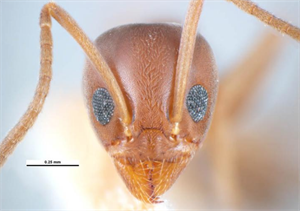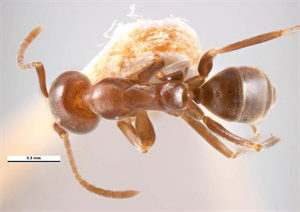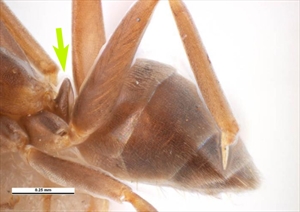Argentine ant, sweet ant (in Argentina).
Pacific Pests, Pathogens and Weeds - Online edition
Pacific Pests, Pathogens & Weeds
Argentine ant (365)
Linepithema humile; previously, Iridomymex humilis.
Asia (restricted), Africa, North (including Hawaii), South and Central America, Europe, Oceania. It is recorded from Australia, and New Zealand (restricted).
An ant that favours subtropical, Mediterranean climates, and environments disturbed by human activities. It survives on a wide range of foods, and where introduced forms super-colonies. It invades houses, contaminating foods of many kinds.
The Invasive Special Specialist Group of the IUCN Species Survival Commission, considers this ant to be one of the most invasive and difficult to manage. Studies have shown that when new introductions occur the workers are genetically similar between different nests, and they cooperate rather than compete. This change in aggression increases the ants' invasiveness. Cooperation allows super-colonies to form, where ants from one nest are accepted by those ants in different nests. Colonies may have more than a million workers, with multiple nests and queens.
There is only one kind of worker in contrast to Solenopsis species. They are dark brown, 2-3 mm long (Photos 1-4). Males are slightly larger, about 3 mm, dark brown, and winged. Queens are larger still, about 5 mm, and virgin queens have long narrow wings. Possibly, workers change their queens each year.
The Argentine ant dose not sting, bite or spray formic acid.
The ants are mostly ground-dwelling; nests are shallow, under wood, stones, or in piles of leaves, rubbish or potted plants. They are located in moist, but not wet areas. More rarely, they make nests in buildings. However, they frequently come into buildings in search of warmth and water.
Food is mainly honeydew and nectar. Honeydew is taken from aphids, mealybugs, scale insects and whiteflies, and in the process these pests are protected from their natural enemies. Other insects are also taken to feed larvae and queens. Many household foods, including those of pests, are readily taken.
Spread occurs by 'budding', when queens and a few workers leave the nest to start of new one nearby. There are no mating flights: fertilisation takes place in the nest. After moving to a new nest, the queens' wings are removed by the workers, fertilised eggs become workers or queens, and those that are unfertilised become males. Long-distance spread occurs in soil of potted plants, in packing material, timber, machinery, and containers shipped around the world. As few as one queen and 10 workers can establish a new colony.
Linepithema humile is known as a 'tramp' ant. These are ants that have become widely distributed globally associated with increased trade and commerce.
The Argentine ant is aggressive, able to alter both natural and agricultural ecosystems. Plant diversity is especially impacted: native ants are displaced, altering seed dispersal of native plant species, and pollinating insects decline due to loss of habitat or competition for nectar. Apart from protecting sap-sucking insect pests, and weakening plants, the honeydew excreted by these ants falls onto leaves and is colonised by sooty moulds turning leave black and blocking photosynthesis.
This ant is one of the five worst ants threatening the Pacific according to PIAT (Pacific Invasive Ant Toolkit, together with the little fire ant, the red imported fire ant, the big-headed ant, and the yellow crazy ant (http://www.piat.org.nz/problem-ants/worst-5-identification).
Look for smooth, shiny, fast moving brown ants with large eyes, no hairs, and a characteristic 'petiole' (see Photo 5, arrow). Look to see the workers forming dense foraging trails to and from food sources.
The PIAkey provides diagnostic descriptions of the Argentine ant: (http://idtools.org/id/ants/pia/Fact_Sheets/Linepithema_humile.html), and numerous photographs. Similar ants are species of Iridomyrmex and Technomyrmex, and side-by-side comparisons with the Argentine ant are provided to distinguish between them.
The app: Antkey Mobile: an identification key for introduced ants. USDA. LUCID, is useful for preliminary examinations, as is the online version: (http://idtools.org/id/ants/pia/PIAkey_v2.html).
The Pacific Invasive Ants Taxonomy Workshop manual has a key to the Pacific species and is well illustrated (http://www.issg.org/cii/Electronic%20references/pii/project_docs/papp/pacific_ants_taxonomy_workshop_2009.pdf).
BIOSECURITY
The Argentine ant is among the 100 of the World's Worst Invasive Alien Species, published by The Invasive Species Specialist Group (ISSG), a specialist group of the Species Survival Commission of the World Conservation Union. (http://www.issg.org/pdf/publications/worst_100/english_100_worst.pdf).
Countries (especially in Asia, the Caribbean, Oceania) that are still free from, but vulnerable to, the Argentine ant, need to: (i) define the risk; (ii) have preventive measures in place against an introduction; (iii) have quarantine protocols enacted in case a breach occurs; and (iv) be able to effect a rapid response against this ant and others. It is important to have rapid response procedures in place in case eradication is a possibility. In addition, it is necessary to have biosecurity regulations to prevent movement of the ant within the country, especially in Caribbean and Pacific island countries where most are island groups or archipelagos. Finally, monitoring is required on the islands still free from infestation.
A Pacific Ant Prevention Plan has been written on behalf of the IUCN/SSC Invasive Species Specialist Group and presented to the Pacific Plant Protection Organisation and Regional Technical Meeting for Plant Protection (2004). The Argentine ant is one of the 11 species covered (http://issg.org/database/species/reference_files/PAPP.pdf). The Plan focuses on ways to prevent the introduction, establishment and spread of this ant.
Guidelines to assist Pacific island countries and territories in planning effective management of invasive species have also been prepared by the Pacific Community and the Secretariat of the Pacific Regional Environment Programme (http://www.piat.org.nz/uploads/PIAT_content/pdfs/SPREP%20guidelines%20for%20invasive%20species%20management%20in%20the%20Pacific.pdf).
The IUCN/SSC Invasive Species Specialist Group website should be consulted for details on all aspects of eradication and management of invasive ants (http://www.issg.org/).
CULTURAL CONTROL
Hot water at 47°C (and above) kills ants. Hot water up to 49°C will not damage plants. A more extreme method is to use fire to destroy the nests and to create conditions that favour native ant species. Sticky bands around trees have been successful, but costs make this method of limited use.
CHEMICAL CONTROL
In general, three types of chemicals are used against ants: (i) stomach poisons. e.g., Maxforce® (fipronil), Amdro® (hydramethylnon), and borax; (ii) insect growth regulators (e.g., Engage® (methoprene), and Distance® (pyriproxyfen); and (iii) poisons that work on the nervous system, that is, neurotoxins, e.g., bifenthrin, fipronil, and thiamethoxam. Stomach poisons kill all queens, intercastes and workers; insect growth regulators stop the queens from laying eggs, whereas neurotoxins disrupt insects' central nervous system. It is likely that future products will combine toxins that cause rapid death and insect growth regulators, e.g., Extinguish Plus® (hydramethylnon and methoprene).
In the case of the Argentine ant, spraying the ants is not usually effective because there are several queens in the nest. A better method is to use hydramethylnon (Amdro®) or fipronil baits that are taken back to the nest and shared among workers and queens. Even this method requires several attempts because each nest has several queens, and they may not all be killed with one attempt.
A note of caution: Although it is possible to combine a lure (such as peanut butter, fish, sugar, etc.) with a pesticide as an ant bait, it is not recommended because of the danger in leaving concentrated pesticides unattended in the environment, including dwellings.
Treatment options (and case studies) are provided in the Pacific Invasive Ant Toolkit under (http://piat.org.nz/getting-rid-of-ants).
____________________
When using a pesticide, always wear protective clothing and follow the instructions on the product label, such as dosage, timing of application, and pre-harvest interval. Recommendations will vary with the crop and system of cultivation. Expert advice on the most appropriate pesticides to use should always be sought from local agricultural authorities.
AUTHOR Grahame Jackson
Information from CABI (2019) Linepithema humile (Argentine ant). Crop Protection Compendium. (https://www.cabi.org/cpc/datasheet/30839); and Pacific Invasive Ant Toolkit. (http://piat.org.nz/); and AntWiki. (http://www.antwiki.org/wiki/Linepithema_humile); and AntWeb. (https://www.antweb.org/description.do?genus=linepithema&name=humile&rank=species); and from Linepithema humile (2018) Global Invasive Species Database. (http://www.iucngisd.org/gisd/speciesname/Linepithema+humile). Photo 1 Whitney Cranshaw, Colorado State University, Bugwood.org. Photos 2-5 Simon Hinkley & Ken Walker (2006) Argentine ant (Linepithema humile). Museum of Victoria. PaDIL - (http://www.padil.gov.au).
Produced with support from the Australian Centre for International Agricultural Research under project HORT/2016/185: Responding to emerging pest and disease threats to horticulture in the Pacific islands, implemented by the University of Queensland and the Secretariat of the Pacific Community.








